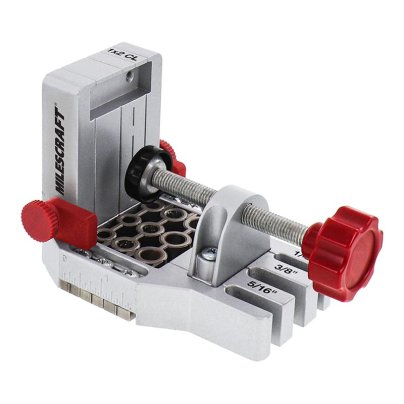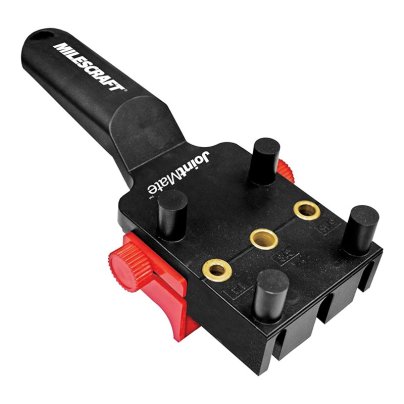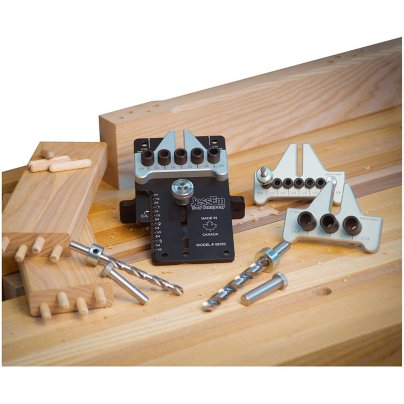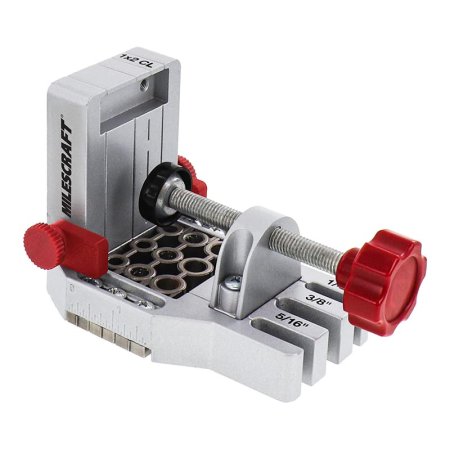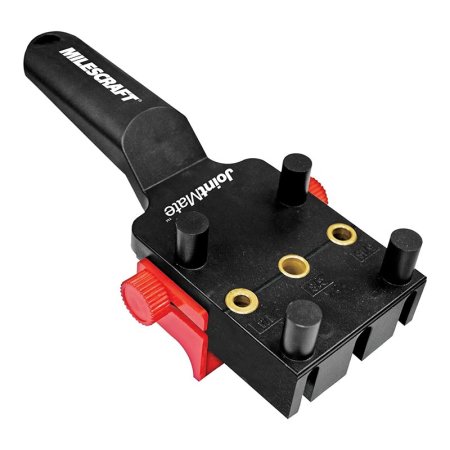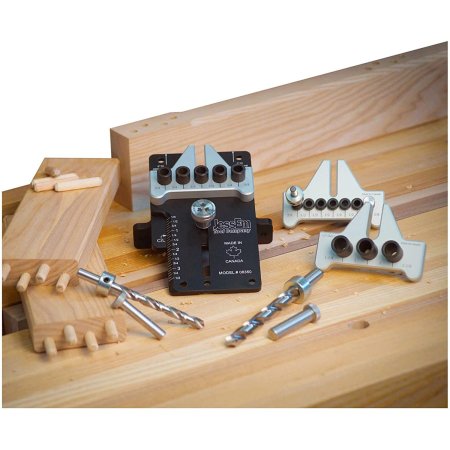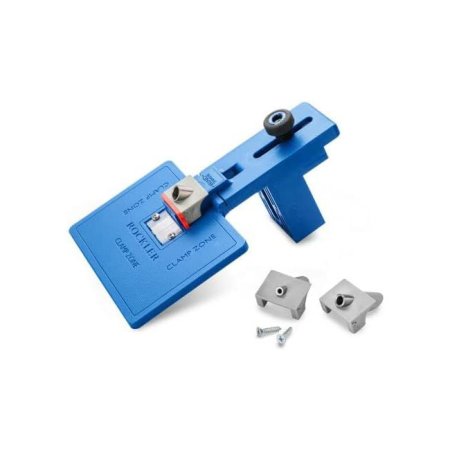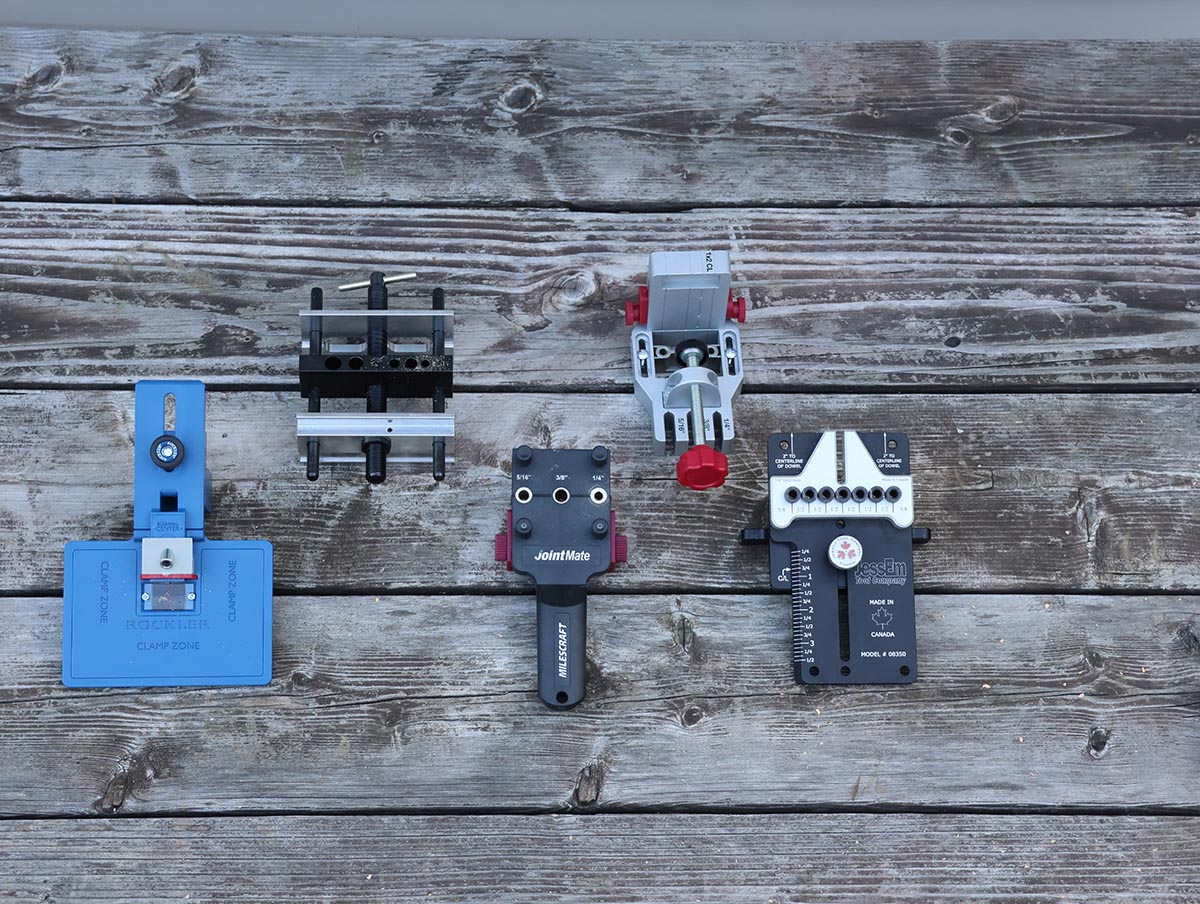
We may earn revenue from the products available on this page and participate in affiliate programs. Learn More ›
When it comes to wood joinery, creating dowel joints is one of the easiest, most accessible options for DIYers to start with and an essential skill in a woodshop—but the right dowel jig can make this task even easier. That’s why we researched more than a dozen dowel jigs and tested six that should suit just about any level of woodworker, from a novice DIYer to a furniture maker.
While joinery has come a long way, with the popularity of pocket hole screws and glues that are stronger than ever, there is still a place in your garage or workshop for an easy-to-use dowel jig.
“There are tons of things around the house a homeowner can use dowel jigs to fix,” says John Mazzuca of Gambrick Construction, a Point Pleasant, New Jersey–based custom home builder with 25 years of experience. “Over time wood chairs can become wobbly … and a dowel jig can [help you] drill new holes into the chair’s legs and back supports for dowels that will reinforce the joints and make the chair sturdy again.” Mazzuca says he also uses dowels to fix the shelving on bookcases or when the case itself starts to pull apart.
These woodworking tools can not only help you fix broken items, but they can also assist your foray into woodworking projects as they smartly align boards for things like cabinets, boxes, and tabletops. Here are the best dowel jigs, based on our hands-on experience, for a variety of projects.
- BEST OVERALL: Milescraft JointMaster
- BEST BANG FOR THE BUCK: Milescraft JointMate
- UPGRADE PICK: JessEm Dowelling Jig Master Kit
- BEST SELF-CENTERING: Task Tools Wide Capacity Economy Jig
- BEST DECORATIVE: Rockler Corner Key Doweling Jig
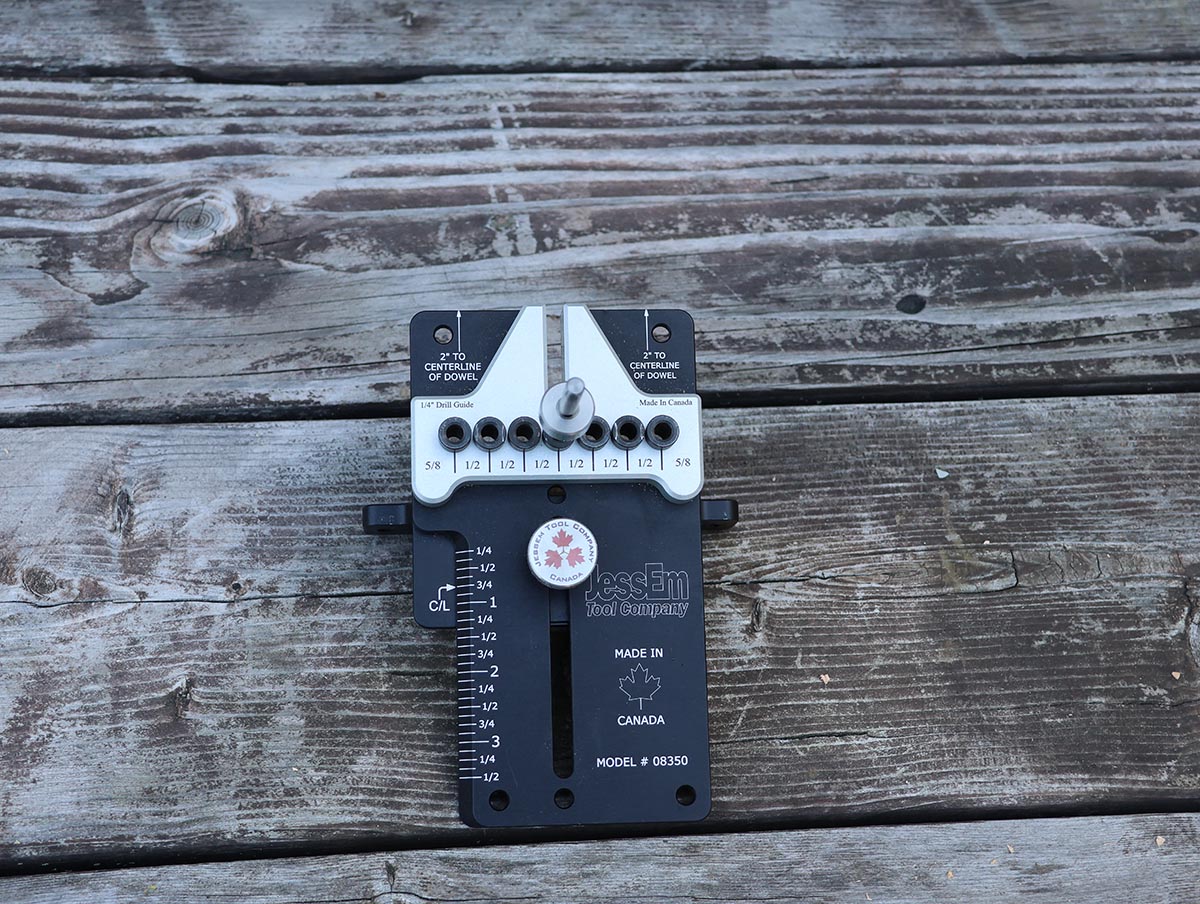
Product Comparison
| Bushing sizes | Materials | Dowels included | Drill bits and stop collars included | |
| Milescraft JointMaster | ¼, 5/16, ⅜ inch | Aluminum and steel | No | No |
| Milescraft JointMate | ¼, 5/16, ⅜ inch | ABS plastic and steel | No | No |
| JessEm Dowelling Jig Master Kit | ¼ inch, ⅜ inch, ½ inch | Aluminum and steel | No | Yes |
| Task Tools Wide Capacity Economy Jig | ¼, 5/16, ⅜ inch, 7/16, and ½ inch | Anodized aluminum and steel | No | No |
| Rockler Corner Key Doweling Jig | ⅛, ¼, and ⅜ inch | Plastic and steel | No | No |
Our Top Picks
These top picks represent highly focused choices to make it easy for woodworkers to find the right combination of performance and value.
Best Overall
Milescraft JointMaster
What We Like
- Handles the 3 most common dowel sizes
- Clamp grips work tightly
- Includes edge stops
- Spacers quickly center the dowels on common stock
What We Don’t Like
- Using a screwdriver to adjust the jig is tedious
- Does not come with dowels, drill bits, or stop collars
Product Specs
- Bushing sizes: ¼, 5/16, ⅜ inch
- Materials: Aluminum and steel
- Dowels included: No
- Drill bits and stop collars included: No
Our Ratings: Ease of use 4.5/5; Stability 5/5; Durability 5/5; Value 5/5
While there are jigs that offer a greater range of dowel size options, the JointMaster is hard to beat when it comes to utility. The boxed kit includes three sleeves to drill ¼-inch, 5/16-inch, and ⅜-inch dowels, which can cover most bases for DIYers. Plus, its smart design makes this jig our favorite. The aluminum body is stiff and won’t bend even when users crank down on the included clamp.
Like a lot of jigs, the JointMaster has indexing fingers to help transfer the location of dowels to make any standard joint. We appreciated the clear cast markings to help center the dowels in stock from ½ inch to 3 inches thick. Users won’t have to worry about those rubbing off with heavy use.
Milescraft included a detail a lot of other jigs leave out: a pair of positive stops that hook onto the end of a board to help with consistent alignment. During testing we flipped either end down to hold the work, enabling this relatively inexpressive jig to deliver accurate results. The jig is assembled in a 90-degree corner, but with a screwdriver, users can take it apart for instances where they need to drill a hole without the fence—say when clamping the jig onto a stair baluster or chair spindle. Users can attach the removable clamp to either half of the jig.
We found the clamp worked on most of our testing, but the Milescraft has a bunch of flat surfaces on its 90-degree body, so if extra clamping is needed, it wouldn’t be difficult to get a secure bite. The kit includes a series of spacers that help center the holes for common board thicknesses like ½ inch, ⅝ inch, ¾ inch, or 1½ inches.
Aside from the bits and stop collars buyers have to provide, the screws are a pain point. Users will need to loosen and tighten two Philips-head screws to swap out bushing guides, adjust the fence position, or break apart the jig. Over time, torquing down on the screws might strip the heads. Still, that’s a small bit of concern to pay for a well-designed and well-built jig that can handle a wide range of doweling projects.
Get the Milescraft JointMaster dowel jig at Amazon or Woodcraft.
Best Bang for the Buck
Milescraft JointMate
What We Like
- Entry-level price
- Drills holes for commonly sized dowels
- Built-in handle makes clamping unnecessary
- Lightweight and easy to store
- Pegs help users find the center of boards
What We Don’t Like
- Can be tedious to manually space holes evenly
- Shape of the jig leaves little space for clamps
- Does not include drill bits or stop collars
Product Specs
- Bushing sizes: ¼, 5/16, ⅜ inch
- Material: ABS plastic and steel
- Dowels included: No
- Drill bits and stop collars included: No
Our Ratings: Ease of use 3.5/5; Stability 3/5; Durability 3/5; Value 5/5
Milescraft’s entry-level dowel jig is about as basic as a dowel jig gets. The tough ABS plastic body has hardened steel bushings for ¼-inch, 5/16-inch, and ⅜-inch drilling holes in material from ½ inch to 1½ inches thick. Clear groves in the body of the tool indicate the center line of the dowels.
The overall design is very user-friendly. Out of the box, we used the four posts sticking up from the face to help center the dowel holes on the edge or end of a board—any time measuring isn’t required is a good thing. We were able to hold the JointMate in one hand and drill a centered hole for the dowel with the other. It would probably be easier if the work was held in a vice, but for quick work, the setup is very fast. The adjustable fence, in conjunction with fingers molded in the front of the tool, allowed us to index the Milescraft on a dowel pin and then transfer the hole’s location to a mating board, so while this is an inexpensive tool, if users take their time with it, they can get accurate results.
During testing, the lightweight plastic felt durable and comfortable in hand. While it helps drill three common dowel diameters, it can take a bit of fussy measuring to evenly space those holes across the width of very long boards, like a tabletop. But for smaller work, where users might only need four or five dowels to line up, this is a great entry-level solution.
The JointMate is a good buy at around $10, but it doesn’t include additional building pieces, such as clamps, drill bits, and stop collars. Milescraft offers a kit version of this tool, which includes drill bits and stop collars, starter dowels, glue, and dowel center pins. That might be a better value for those who need to start building immediately.
Get the Milescraft JointMate dowel jig at Amazon or The Home Depot.
Upgrade Pick
JessEm Dowelling Jig Master Kit
What We Like
- Solid aluminum construction is virtually unbreakable
- Provides the ability to drill 3 different-size dowels
- Laser-engraved measurement markings
- Indexing pins make it intuitive to position dowels
What We Don’t Like
- Switching out the bushing sizes requires the hex key
- Cannot clamp material
Product Specs
- Bushing sizes: ¼ inch, ⅜ inch, ½ inch
- Material: Aluminum and steel
- Dowels included: No
- Drill bits and stop collars included: Yes
Our Ratings: Ease of use 4.5/5; Stability 4/5; Durability 5/5; Value 4/5
The JessEm dowel jig is aimed at professionals, not because the jig is particularly complex—inexperienced woodworkers can handle it—but because of the variety and accuracy of holes it creates. With steel bushings and screws, this capable anodized aluminum jig works on a wide range of projects. Though it’s on the pricey side, the JessEm was the only one in our testing that came with drill bits and stop collars.
Joining end grain is always difficult, and most dowel jigs are not well suited for the task. However, with the ability to space dowels a mere ⅛ inch apart and a stainless steel indexing pin, the JessEm jig easily tackles the job. Users drop into the first hole, so any subsequent holes are accurately spaced no matter the size of the board. Proper clamping also helps achieve that kind of accurate repeatability, and we found that the flat surfaces of this jig provide ample clamping room.
We also liked the JessEm’s three quick-change sleeves; we didn’t have to change individual bushings to switch between dowel sizes. Seven ¼-inch bushings occupy one; five ⅜-inch bushings are on another; and three ½-inch bushings fill the last. The dowels can be set anywhere from ¼ inch to 3½ inches from the board edge, which is a unique attribute that provides fast, consistent spacing. The oddly shaped but useful U-shaped slot in the front of the jig can, with the indexing pin or a dowel, transfer a hole’s location from one board to another to ensure accurate alignment across edge-to-edge joints, 90-degree corners, or T joints.
The only downsides to this product that we noticed were having to supply our own clamp and keeping track of the ⅛-inch hex key required to switch between bushing sizes. Overall, however, we found that this well-designed product was a joy to use.
Get the JessEm dowel jig at Acme Tools, Lee Valley, or Infinity Tools.
Best Self-Centering
Task Tools Wide Capacity Economy Jig
What We Like
- Big but easy to use, especially on larger stock
- Self-centering feature
- The heavy build is accurate and should last a lifetime
- Includes the rarer 7/16-inch and ½-inch dowels
What We Don’t Like
- Can be cumbersome to work with
- Does not help with transposing the dowel location
- Doesn’t help users evenly space a series of dowels
Product Specs
- Bushing sizes: ¼, 5/16, ⅜ inch, 7/16, and ½ inch
- Material: Anodized aluminum and steel
- Dowels included: No
- Drill bits and stop collars included: No
Our Ratings: Ease of use 5/5; Stability 5/5; Durability 5/5; Value: 4/5
The Task Tools jig is a two-in-one for what can be tough doweling. Not only can it handle timbers and posts up to 6 inches wide, but it also centers the dowel holes automatically, enabling users to find the middle of round stock, too. The chunky screw-style vise makes this just about the easiest jig to use because it securely hugs any stock that fits within its jaws. The Task also has five fixed bushings, so it can handle a wide range of wood stock.
If your goal is to put holes in the center of stock, this is the jig for you because it does exactly what it says and with few moving parts. While using the jig, we noticed the hefty feel of anodized aluminum construction, which should last for years thanks to the rust-resistant coating. We also found it easy to attach the Task to wood pieces as thin as ⅜ inch thick, and the precise bushings were accurate through the range of sizes.
On the downside, this jig is not designed to help users transfer dowel locations from one board to the next. That means it falls on the user to make more accurate layout marks and a bit more patience to nail the location of mating holes. Plus, at well over 2 pounds, the jig can overwhelm smaller pieces of wood, which users might want to clamp into a vice to keep secure. During testing, we had to clamp a 2×4 to the work surface while drilling through the narrow end of the stock, which helped increase stability.
Get the Task Tools dowel jig at Amazon or Rockler.
Best Decorative
Rockler Corner Key Doweling Jig
What We Like
- Easy to put a decorative dowel through a corner joint
- Wide body of the jig provides plenty of clamping surface
- User-friendly markings; easy fence adjustments
What We Don’t Like
- Limited use as a specialty jig
- Does not include dowels, drill bits, stop collars, or clamps
Product Specs
- Bushing sizes: ⅛, ¼, and ⅜ inch
- Material: Plastic and steel
- Dowels included: No
- Drill bits and stop collars included: No
Our Ratings: Ease of use 5/5; Stability 4/5; Durability 3/5; Value 4/5
This specialty plastic jig comes in two pieces and is designed to put a dowel through a 90-degree corner, resulting in a decorative finish and strong connection on boxes and cabinets. Woodworkers often use a wood dowel that contrasts with the box material so the connection pops and adds a decorative touch. Other materials, like metal rods or leather laces (to tie the joints together), can also be used.
The jig is simple to set up out of the box with easy-to-read markings for adjusting the fence based on the thickness of the stock. During testing, the plastic and metal bushings were easy to swap in and out without a tool. Although the kit does not come with drill bits or a clamp, we liked the clear center line on the jig’s alignment window, which makes it easy to put the dowel right where users want it. This is a nice jig to have for more experienced DIYers who dabble in case work.
Get the Rockler dowel jig at Amazon or Rockler.
ALSO TESTED
Dowelmax Classic ⅜ Joining System
While we were impressed with the heft, quality, and precision milling of the Dowelmax, it’s a bit too complex for a DIYer. Setting the Dowelmax up takes a bit of time, more than any other tools in the test. While most dowel jigs might need a read or two of the manual, before shoving it into a drawer, a user will likely need to keep the booklet that comes with the Dowelmax (along with an instructional DVD) on hand.
It also takes way more attention to align the parts of the jig up to correlating parts of the wood, based on a check embossed on the aluminum. And also for the higher price, it can only drill ⅜-inch dowels. Other dowel guides are sold a la carte. For an experienced woodworker looking for a viable option to a biscuit jointer or floating tenon power tool, this might be a viable option, but for most DIYers, the Dowelmax would be overkill.
Jump to Our Top Picks
How We Tested the Best Dowel Jigs
In deciding which dowel jigs to test, we carefully evaluated the market and looked for reliable products with the most sought-after features. To suit beginner DIYers, we looked at price-friendly options that are capable of the three most common doweling sizes (¼ inch, 5/16 inch, and ⅜ inch). With pros in mind, we researched high-end models that include features such as laser engraving for durability and ease of use as well as precision-engineered joining systems that can help more experienced users produce better results.
After considering several products, we picked six to test and found five worth recommending to cover the needs of a wide range of users, from entry-level budget-minded buyers to experienced woodworkers.
We tested the tools for 3 hours over the course of a few days by drilling holes in commonly sized stock, making edge-to-edge joints that simulate a tabletop, 90-degree corners, T joints, and corner joints all in softwood using commercially available dowels. We evaluated ease of use, accuracy, and utility when judging which dowel jigs to recommend.
| Ease of Use | Stability | Durability | Value | |
| Milescraft JointMaster | 4.5 | 5. | 5 | 5 |
| Milescraft JointMate | 3.5 | 3 | 3 | 5 |
| JessEm Dowelling Jig Master Kit | 4.5 | 4 | 5 | 4 |
| Task Tools Wide Capacity Economy Jig | 5 | 5 | 5 | 4 |
| Rockler Corner Key Doweling Jig | 5 | 4 | 3 | 4 |
What to Consider When Choosing a Dowel Jig
Dowel jigs vary widely in shape, design, and complexity. The plethora of options can make choosing the right one difficult. The following section looks at several important considerations when shopping for the best dowel jig for a range of workshop tasks.
Intended Use
Dowels are used to secure several types of joints: T joints, 90-degree corner joints, mitered corner joints, edge-to-edge joints, and lapped joints.
While most dowel jigs offer a degree of versatility, they may not be suitable for all joint types. Learn the full range of functions provided by a particular model before purchasing one. Buying a basic dowel jig can save money initially, but experienced woodworkers may want to invest in a more versatile model.
Dowel jigs are sometimes described as basic, intermediate, and advanced, but this terminology can be misleading. An inexperienced woodworker shouldn’t necessarily opt for a simpler device. While the dowel jig may look easier to use initially, it might actually be more difficult to set up and lack the precision of a more advanced model.
Bushing Size and Material
The purpose of a dowel jig is to drill accurate holes in a piece of wood. Users then fit dowels into these holes and glue the project together. While exceptions exist, the hole for the dowel should be between one third and one half the thickness of the workpiece—any larger and the hole can weaken the joint. It’s also good practice, when drilling dowel holes, to leave some extra room in the pocket to accept any glue that will pool. Plan to leave about ⅛ inch of extra space on each end of the wood peg by drilling a hole that’s about ¼ inch deeper than the dowel is long.
To provide the necessary versatility, manufacturers typically offer a number of different bushes (or the drill guide) with the purchase. Basic dowel jigs usually include one or two bushes; more advanced models may provide up to six. Common bush sizes (3/16 inch, ¼ inch, 5/16 inch, ⅜ inch, 7/16 inch, and ½ inch) match the widely available dowels that come in economical packs of 100 or more.
On low-cost dowel jigs, the bushes may be made of low-cost, easy-to-produce aluminum; however, the hard steel of a drill bit will wear it out eventually. For those who use a dowel jig only occasionally, this isn’t a problem, but regular users will get more value from a jig with longer-lasting hardened steel bushes.
Clamping Performance and Accuracy
Handheld dowel jigs may be easy to position, but the possibility of movement always exists when drilling, which can cause inaccuracies and ruin the job. Many dowel jigs can be clamped securely in place to prevent movement from occurring. The clamping method, along with capacity, varies among different types of jigs.
Entry-level dowel jigs might require clamping, but the clamps often aren’t included. Some of the better dowel jigs clamp to both sides of the workpiece. Not only are these jigs easy to operate, but their drill bush frequently will center itself, which improves accuracy and also can improve efficiency.
Ease of Use
In principle, creating dowel joints is straightforward. Once users have clamped the jig or held it onto the workpiece, they’ll drill the dowel hole into the wood. Ease of use becomes simply about how quickly the jig can be set up and ready for drilling. The detail that makes a dowel jig more accurate, and therefore easier to use, is the method in which it helps transfer the holes from one board to the other. Most jigs do this without users having to get out a tape measure. A series of fingers nestle around an existing hole fitted with its dowel and then help users align its corresponding hole. This ensures accuracy so there are no surprises when gluing.
Every so often there might be a situation where the alignment fingers won’t work, and in that case, a few dowel center transfer markers can help. Offered in common dowel diameters, these pins fit into the holes in one half of the project. Then press the board into the mating one, and the pins on the markers identify the center of the correlating dowel holes.
Features like self-centering are a bonus for some woodworkers, as is a choice of six different bushes. However, those who usually work with similar-size lumber may not need to change bushes or accommodate different widths, so they don’t need a high-end model. While precise clamping is vital for some tasks, a low-cost handheld dowel jig is the right tool for others. The right jig for you is the right jig for your tasks.
FAQs
Q. How do I choose a dowel size?
When creating edge and corner joints, ideally, the dowel should be one third the thickness of the board you’re joining. While up to half the thickness of the board is permissible, don’t go any further. For large overlapping joints, size is rarely important.
Q. How far apart should dowels be placed?
It depends on the job. On end-grain material, dowels can be as close as practical to provide maximum support. On 1- to 2-foot boards, place a dowel approximately 1 inch from each end and 4 to 6 inches apart in between. On long boards, position dowels up to 10 inches apart.
Q. Do dowels need glue?
Yes. Dowel joints are intended to be permanent, so apply a small amount of glue. If you think you will want to disassemble your project at some point, consider using a pocket hole jig, which uses removable screws rather than dowels.
Q. How much weight can a dowel hold?
While many variables impact the amount, some experts in the field note that a 1-inch dowel can hold 3,000 to 4,000 pounds.
Q. Why are dowels often used in making an edge joint?
Dowels make it easy to align surfaces and prevent them from slipping while the glue dries, which can dramatically reduce the need for corrective work later.
Meet the Tester
Sal Vaglica has covered tools and DIY projects since 2006 for such sites as Better Homes & Gardens, Wired, This Old House, and Fine Homebuilding. A former hardwood flooring contractor, he prefers to test tools hands-on whenever possible by replicating the scenario readers might face at their own homes.
Additional research provided by Bob Beacham.
